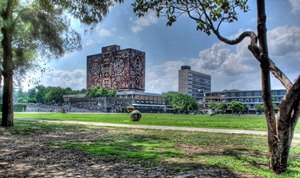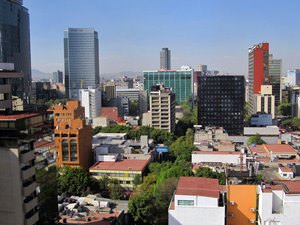 What are the most important landmarks to see first and foremost in Mexico City? Without a doubt, the original architecture of the city deserves the highest attention. National Palace, Chapultepec Castle, Torre Latinoamericana, Palacio de los Deportes, La Santísima Church and many others – are the architectural landmarks that attract millions of tourists every year. Let’s visit Mexico City right now by making a virtual tour using our fantastic 3D flight simulator! Just start the video on this page and make a flight over the main sites of Mexico City, which are presented in a three-dimensional format. Besides that, our review includes interesting facts and colorful photos of every monument.
What are the most important landmarks to see first and foremost in Mexico City? Without a doubt, the original architecture of the city deserves the highest attention. National Palace, Chapultepec Castle, Torre Latinoamericana, Palacio de los Deportes, La Santísima Church and many others – are the architectural landmarks that attract millions of tourists every year. Let’s visit Mexico City right now by making a virtual tour using our fantastic 3D flight simulator! Just start the video on this page and make a flight over the main sites of Mexico City, which are presented in a three-dimensional format. Besides that, our review includes interesting facts and colorful photos of every monument.
National Palace, Mexico
Location on the map:  Facts:
Facts:
» The Head of State and the Ministry of Finance have settled in the National Palace of red brick. It is located in Constitution Square (Zocalo). The building project was endorsed by the conquistador in 1692. » The President’s study, living room and bedroom (1860) are open for visitors. The exhibition is organized here. Personal belongings of the politician are kept here too. The items displayed will tell about the establishment of the Mexican Congress.
» Museum exhibits are displayed in 19 halls. At the first level, the wall painting from the floor to the ceiling shows the city as it looked like before the Spanish conquerors had come.
» The walls of the second floor are covered with frescoes that depict the 2000-year-old history of Mexico. One of the sides of the painting depicts aborigines’ life.
» The other one shows the pictures of today’s country. The master has decorated the panels for 16 years. He expressed the stages of the state development in his pieces of art.
» There are three entrances to the palace. The first one leads to prison cells and the torture chamber. The Southern entrance that is closed for tourists leads to the President’s equipment room. The Central one leads to a comfortable patio.
» There is a fountain and a garden with special types of cactuses. The palace resembles a fortress with its exterior.
Chapultepec Castle, Mexico
Location on the map:  Facts:
Facts:
» The Indians living here in the 8th century where the palace is located today called the hill Chapultepec, which is literally translated as “the hill of grasshoppers”. » At its top, there is the former building of Mexican rulers of the 18th century. Over the years of its existence, Castillo de Chapultepec had served as the Emperor’s house, a military academy, and an astronomical observatory.
» Today, the national History Museum presents exhibitions about the history of ancient and modern Mexico. The interior of rooms on the ground and first floors have been preserved since the period of the Emperor’s reign. Here, you can see antique furniture and such household items, as old mirrors, tableware, and paintings.
» The Emperor’s Dining Room will impress you with the carved wooden ceiling. The hall is decorated with painted stained glass. The bathroom has remained almost unchangeable. In 19 showrooms, you can see medieval munitions, different weapons, and household items that represent historical moments of the country.
» The castle has another amazing feature: there is a botanical garden on the roof, in the open air.
» Near the building, there is an observation tower built in 1833. Near the castle, there is a parking area with a total area of 686 hectares. There are a zoo and different themed museums in its territory.
Torre Latinoamericana, Mexico
Location on the map:  Facts:
Facts:
» Torre Latinoamericana is a 183-meter skyscraper. The construction itself is 138 meters high plus 44 meters of the antenna. It is an excellent pointer that is seen from any part of the city. » The tower has 44 floors. The museum occupies 36th-44th levels. On the 30th floor, there is Bicentenario, the museum that tells about 200 years of history. Here, you can see portraits of political figures, awards, and outfits. The 37th level is occupied by a cafe and gift shops. On the 38th floor, there is a photo exhibition and the exposure “The City and the Tower throughout the Centuries”. The model of the tower is interesting too. The 42nd and 43rd levels are glazed platforms called Mirador. The 44th floor is an open platform covered with metal mesh. Tourists can use automatic telescopes here.
» The building is finished mostly with glass and aluminum. The Torre Latinoamericana started to be built in 1949. It was completed in seven years.
» It was the first time when technological novelties that let skyscrapers withstand any seismic load had been used. 361 support beams are 33 meters underground. Piles were constructed in such a way that the tower was not destroyed in the earthquake (1957-1985).
» The building has a total weight of over 24 tons and a total area of almost 28 square meters.
Palacio de los Deportes, Mexico
Location on the map:  Facts:
Facts:
» Palacio de los Deportes is a home sports ground for different competitions. » It is included in the single Magdalena Mixhuca Sports City Complex. Leisure activities, exhibitions, and music concerts are also held here.
» The capacity of the sports ground is 20 thousand spectators. In 1958, the International Basketball Championship was held here. The arena can be also used as a volleyball field.
» The palace complex is an oval construction with a rectangular playground. Palacio de los Deportes is an indoor arena.
» The dome is covered with a waterproof transparent cloth. The ceiling is upheld by reinforced concrete and steel arches. Its total area is 27 m2. There is a parking area for visitors’ convenience.
» The building has three floors. The first level is designed for rooms for players, referees, and invited individuals. There are separate commentator’s cabins. The second level includes the central entrance, spacious lobbies, and pathways to stands. The third platform is a special stand for VIPs.
La Santísima Church, Mexico
Location on the map:  Facts:
Facts:
» La Santísima Church has been built for over a hundred years. The first church was completed on 19 September 1667. » Over time, the building was destroyed and needed to be restored. In 1754, it was closed for worshipers upon the order of the Archbishop due to the lack of funding. It was decided to build a new church in 12 months.
» After the restoration and reconstruction in 1783, the church was blessed for holding services.
» Many decorative figurines outside are very impressive. There are busts of twelve apostles. Exquisite sculptures represent missionaries who came here to introduce the locals to the Christian faith.
» The sculpture of Jesus putting his head on God’s knees has a magic influence on people. Worshippers visit La Santísima Church exactly for this purpose.
» The unique music clock voices the national anthem.
» The observation platform has a panoramic view of the historic city center.
» In 1932, the church and adjacent hospitals have been added to the register of the national attractions of Mexico.
National Anthropology Museum, Mexico
Location on the map:  Facts:
Facts:
» Every year, almost 2 million people visit the Anthropology Museum to learn about the origin and development of the human race. » There is a solid stone block at the entrance. The boulder represents the god of rainfalls. The 168-ton basalt statue was found in one of the Mexican cities.
» The Museum in Mexico is divided into 2 sectors, each of which includes 11 showrooms. The ground floor is an anthropological hall. It houses the collection telling about classes of people living in South America.
» The main attraction is an ancient calendar, the Sun Stone, that represents the life of the Aztec tribe living in the Valley of Mexico.
» The second level displays an ethnographic exposure. It tells about the life of modern Mexicans from all parts of the world. You can also use the services of audio guides.
» In the lobby, you can see static pictures of the museum and its exhibits. There is a fresco that depicts the jaguar and the dragon on the wall. It was created by the famous avant-garde artist Tamayo.
» In the courtyard, there is a fountain in the shape of a stone umbrella. The 11-meter handle upholds the dome, from which the water falls.
Temple de San Juan Bautista, Mexico
Facts: » In 1944, the village of Nuevo San Juan Parangaricutiro was fully destroyed by the lava of the erupting volcano. Temple de San Juan Bautista built in the 16th century was affected by the natural disaster too.
» The hot lava broke through the fence and entered the church. Only the altar and the spire of the burnt chapel have remained undamaged. You can still see them surrounded by the ruins of the temple.
» There is talk that the long chime is heard in the surroundings. The fragments of the white building are surrounded by fossils and make a contrast with a black field. The back wall of the construction broke off. The side walls, the front part of the facade, and the altar have remained almost unchangeable.
» The locals came here to lay flowers on the altar before the Easter. Song festivals and religious rites are held near the preserved chapel.
» San Juan Parangaricutiro Church is the only unit of the old construction that still can be seen in the 25-kilometre lava field.
» The villager sold his plot to the artist. He painted a thousand pictures of this unusual place. There is the House of God in the foreground. The natural disaster is also mentioned in many literary works.









